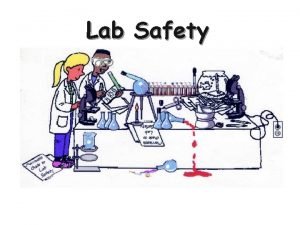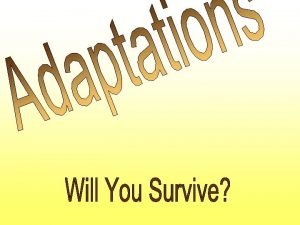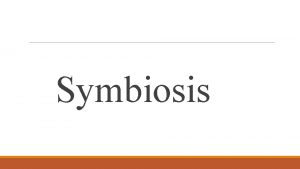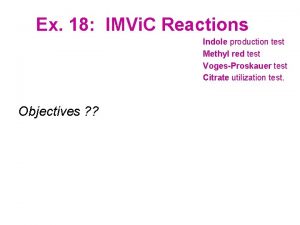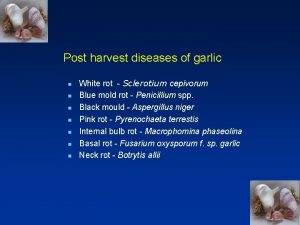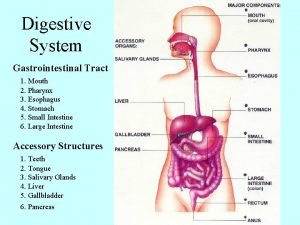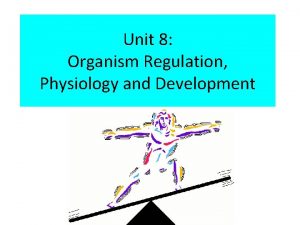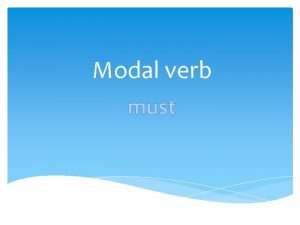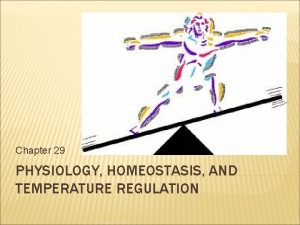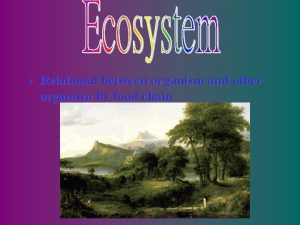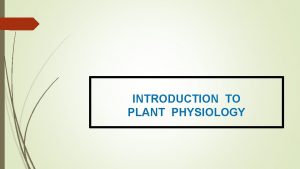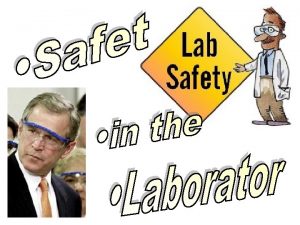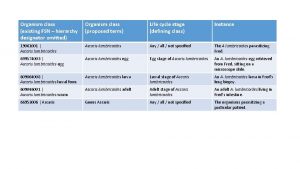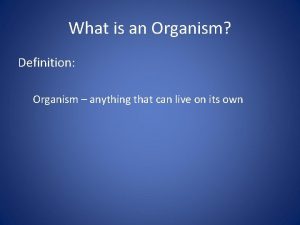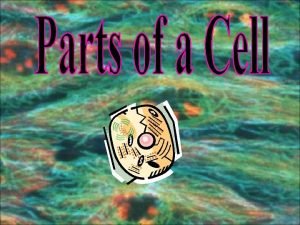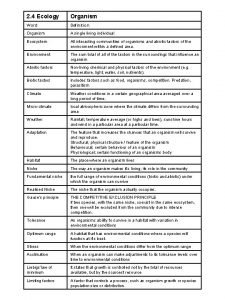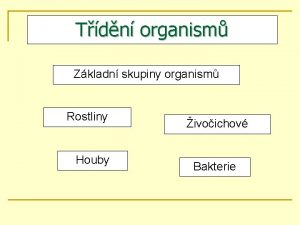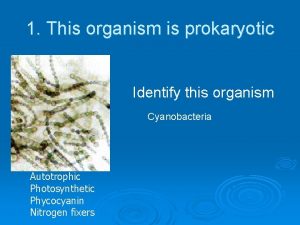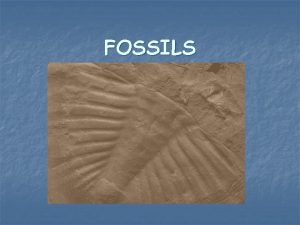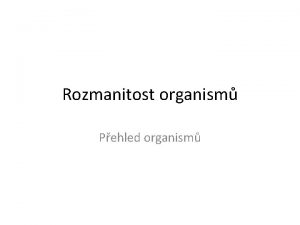Organism Regulation Physiology and Development WHAT YOU MUST


































- Slides: 34

Organism Regulation, Physiology and Development

WHAT YOU MUST KNOW: 1. The importance of homeostasis from a cell to an organism to an ecosystem. 2. How feedback systems control homeostasis. 3. Examples of positive and negative feedback. 4. How systems are affected by disruptions in homeostasis. 5. How structures (adaptations) have evolved to maintain homeostasis showing common ancestry.

Feedback Loops • Used at all levels of organization in living systems. • Two types: 1. Negative Feedback 2. Positive Feedback

Negative Feedback • They regulate systems or processes • Maintains homeostasis at a set point or range • The response (or feedback) to the stimulus decreases the occurrence of the stimulus or is opposite of the stimulus. – Examples: Lac operon, temperature regulation, plant responses to water limitations, population growth, blood sugar and blood calcium regulation


Positive Feedback • Amplifying in nature • The response is to amplify or increase the occurrence of the stimulus. – Examples: labor, fruit ripening and lactation in mammals

Effects of Disruptions • Seen at all levels of organization • Molecular and cellular level: – Ex: Response to toxins • interferes with specific metabolic pathways or cause cell damage – Ex: Dehydration • Too much water loss causes cellular environment to be too hypertonic. Cellular work stops. Death… – Ex: p. H change in the bloodstream – Ex: blood sugar concentrations

Ecological Disruptions • Affects balance of the ecosystems • Examples: – Invasive species: outcompetes native species or places a rapid stress on natives – Natural disturbances: fires, earthquakes etc.

Note: as long as disruption is not too large and too rapid for homeostatic feedback loops to function, rebound will occur. Otherwise, disease, degradation and death are unavoidable.

Physiological Interactions • Multicellular organisms are organized into organ systems, which contain organs that work together to accomplish life processes. • Organ systems also interact for life processes – Examples: • • • Stomach and small intestine Plant organs Respiratory and Circulatory System Nervous and Muscular System Kidney and bladder

Animal systems evolved to support multicellular life aa O 2 CH single cell CHO CO 2 aa NH 3 CHO O 2 CH aa CO 2 aa NH 3 CO 2 O 2 aa CH NH 3 CO 2 NH 3 AP Biology CO 2 NH 3 CO 2 aa intracellular waste O 2 NH 3 but what if the cells are clustered? CHO Diffusion too slow! extracellula r waste for nutrients in & waste out

Circulatory systems § Basic structures needed: circulatory fluid = “blood” u tubes = blood vessels u muscular pump = heart u open hemolymph AP Biology closed blood

Vertebrate circulatory system § Adaptations in closed system u 2 low pressure to body number of heart chambers differs 3 4 low O 2 to body high pressure & high O 2 to body What’s the adaptive value of a 4 chamber heart? 4 chamber heart is double pump = separates oxygen-rich & AP Biology oxygen-poor blood; maintains high pressure

Why do we need a respiratory system? respiration for respiration § Need O 2 in for aerobic cellular respiration u make ATP u § Need CO 2 out u food waste product from Krebs cycle O 2 AP Biology ATP CO 2

Gas exchange § O 2 & CO 2 exchange between environment & cells u need moist membrane u need high surface area AP Biology

Optimizing gas exchange § Why high surface area? maximizing rate of gas exchange u CO 2 & O 2 move across cell membrane by diffusion u § rate of diffusion proportional to surface area § Why moist membranes? moisture maintains cell membrane structure u gases diffuse only dissolved in water u AP Biology High surface area? High surface area! Where have we heard that before?

Gas exchange in many forms… one-celled amphibians echinoderms insects fish mammals cilia AP Biology • size water vs. land • endotherm vs. ectotherm

Counter current exchange system § Water carrying gas flows in one direction, blood flows in opposite direction Why does it work counter current? Adaptation! AP Biology just keep swimming….

How counter current exchange works 70% front 40% 100% back 15% water 60% 30% 90% counter 5% current blood 50% 70% 100% 50% 30% concurrent water 5% blood § Blood & water flow in opposite directions u AP Biologyu maintains diffusion gradient over whole length of gill capillary maximizing O 2 transfer from water to blood

Evolution of gas exchange structures Aquatic organisms external systems with lots of surface area exposed to aquatic environment Terrestrial moist internal respiratory tissues with lots of surface area Ex: Human alveoli = 100 m 2 AP Biology

Gas Exchange on Land § Advantages of terrestrial life u air has many advantages over water § higher concentration of O 2 § O 2 & CO 2 diffuse much faster through air w respiratory surfaces exposed to air do not have to be ventilated as thoroughly as gills § air is much lighter than water & therefore much easier to pump w expend less energy moving air in & out Why don’t § Disadvantages u land animals use gills? keeping large respiratory surface moist causes high water loss § reduce water loss by keeping lungs internal AP Biology

Believe it or not… § Your kidneys are only 4 in long and weigh about § § § § 5 oz (weight of ½ unfinished can of pop) Usually we urinate 1. 5 -2. 5 liters/day 44 gallons of blood is filtered by kidneys everyday-2 bathtubs full Fresh urine is cleaner than spit, cleaner than your hands after they have been washed and cleaner than the sandwich you will eat for lunch Gandhi drank urine every day (Tantric Yoga practice) Gladiators brushed their teeth with it Colonial housewives cleaned their home with it 1 st football=pig bladder AP Biology

Nitrogen waste § Aquatic organisms u u can afford to lose water ammonia § most toxic § Terrestrial u u need to conserve water urea § less toxic § Terrestrial egg layers u u u need to conserve water need to protect embryo in egg uric acid AP Biology § least toxic

Osmoregulation § Osmoregulation: control solute concentrations and balance water gain/loss § Excretion: removal of nitrogenous wastes from body Types of Nitrogenous Wastes: Wastes 1. Ammonia – water soluble, very toxic; aquatic animals 2. Urea – produced by liver; less toxic, conserves water; most vertebrates 3. Uric acid – excreted as paste or crystals; birds & reptiles AP Biology

How to make urine: Ø Water and solutes enter filtrate; blood cells and proteins remain in body fluid. Ø Reclaim glucose, vitamins, hormones Ø Add toxins and excess ions Ø Filtrate leaves body as urine AP Biology

From blood filtrate to urine SECRETION FILTRATION REABSORPTION EXCRETION AP Biology

Maintaining Water Balance § High blood osmolarity level u too many solutes in blood Get more water into blood fast § dehydration, high salt diet u u stimulates thirst = drink more release ADH from pituitary gland § anti-diuretic hormone u increases permeability of collecting duct & reabsorption of water in kidneys H 2 O § increase water absorption back into blood § decrease urination AP Biology Alcohol suppresses ADH… makes you urinate a lot! H 2 O

Endocrine System Control Blood Osmolarity ADH increased water reabsorption pituitary nephron high blood osmolarity blood pressure adrenal gland increased water & salt reabsorption low Juxta. Glomerular Apparatus nephron renin aldosterone AP Biology increase thirst angiotensinogen

Endothermy and Ectothermy § Endothermic animals generate heat by metabolism; birds and mammals are endotherms § Ectothermic animals gain heat from external § sources; ectotherms include invertebrates, fishes, amphibians, and reptiles AP Biology © 2011 Pearson Education, Inc.

Thermoregulation Methods § Five adaptations help animals thermoregulate: 1. 2. 3. 4. 5. AP Biology Insulation Circulatory adaptations Cooling by evaporative heat loss Behavioral responses Adjusting metabolic heat production © 2011 Pearson Education, Inc.

Circulatory Adaptations § Regulation of blood flow near the body § surface significantly affects thermoregulation Many endotherms and some ectotherms can alter the amount of blood flowing between the body core and the skin u In vasodilation, blood flow in the skin increases, facilitating heat loss u In vasoconstriction, blood flow in the skin decreases, lowering heat loss AP Biology © 2011 Pearson Education, Inc.

Figure 40. 7 AP Biology

Organisms exchange heat by four physical processes: AP Biology

Countercurrent heat exchangers transfer heat between fluids flowing in opposite directions reducing heat loss AP Biology
 Food chain
Food chain You must unlearn what you have learned
You must unlearn what you have learned Wear goggles in lab
Wear goggles in lab If you love god you must hate evil
If you love god you must hate evil I'm sorry that i didn't finish my homework last night
I'm sorry that i didn't finish my homework last night He must become more i must become less
He must become more i must become less Tell me what you eat and i shall tell you what you are
Tell me what you eat and i shall tell you what you are That you must love me and love my dog summary
That you must love me and love my dog summary Describe the chemistry and main ingredients of uv gels
Describe the chemistry and main ingredients of uv gels Unit 3 house and home
Unit 3 house and home светр
светр Anything that surrounds us
Anything that surrounds us Caribbean cleaners national geographic
Caribbean cleaners national geographic Could an organism be both mr and vp positive
Could an organism be both mr and vp positive Causal organism of neck and bulb rot in garlic is _____
Causal organism of neck and bulb rot in garlic is _____ You say that you love rain
You say that you love rain Agree or disagree questions about life
Agree or disagree questions about life If you think you can you can poem
If you think you can you can poem I will follow you follow you wherever
I will follow you follow you wherever Lower respiratory structures
Lower respiratory structures Tattoo anatomy and physiology
Tattoo anatomy and physiology International anatomy olympiad
International anatomy olympiad Specialized stems examples
Specialized stems examples Anatomy and physiology bone
Anatomy and physiology bone Pud
Pud Microbial physiology lecture notes
Microbial physiology lecture notes Liver physiology and anatomy
Liver physiology and anatomy Hypogastric region
Hypogastric region Epigastric vs hypogastric
Epigastric vs hypogastric Blood in anatomy and physiology
Blood in anatomy and physiology Chapter 14 anatomy and physiology
Chapter 14 anatomy and physiology Exercise physiology for health, fitness, and performance
Exercise physiology for health, fitness, and performance Endomysium
Endomysium Large intestine histology
Large intestine histology Http://anatomy and physiology
Http://anatomy and physiology


